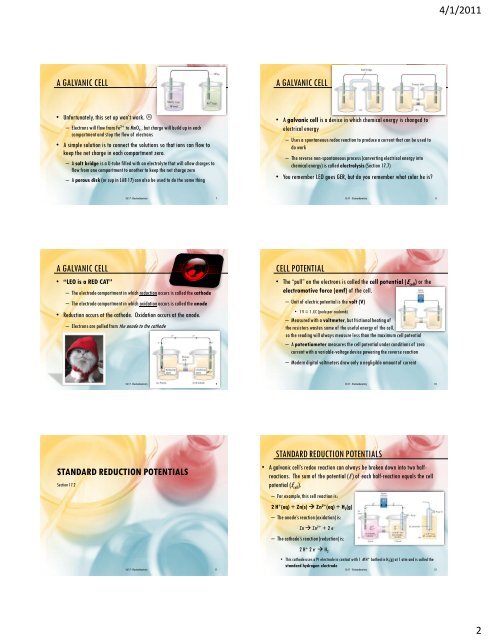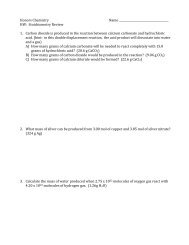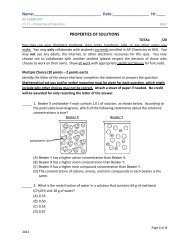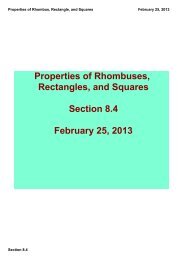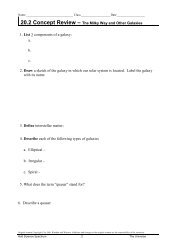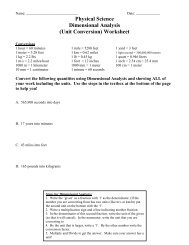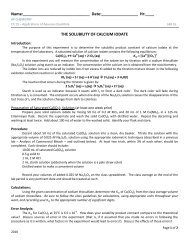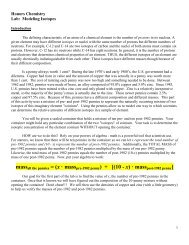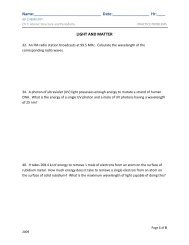Electrochemistry (Ch 17) - AP Chemistry
Electrochemistry (Ch 17) - AP Chemistry
Electrochemistry (Ch 17) - AP Chemistry
Create successful ePaper yourself
Turn your PDF publications into a flip-book with our unique Google optimized e-Paper software.
4/1/2011<br />
A GALVANIC CELL<br />
A GALVANIC CELL<br />
• Unfortunately, this set up won’t work. <br />
– Electrons will flow from Fe 2+ to MnO 4- , but charge will build up in each<br />
compartment and stop the flow of electrons<br />
• A simple solution is to connect the solutions so that ions can flow to<br />
keep the net charge in each compartment zero.<br />
– A salt bridge is a U-tube filled with an electrolyte that will allow charges to<br />
flow from one compartment to another to keep the net charge zero<br />
– A porous disk (or cup in LAB <strong>17</strong>) can also be used to do the same thing<br />
• A galvanic cell is a device in which chemical energy is changed to<br />
electrical energy<br />
– Uses a spontaneous redox reaction to produce a current that can be used to<br />
do work<br />
– The reverse non-spontaneous process (converting electrical energy into<br />
chemical energy) is called electrolysis (Section <strong>17</strong>.7)<br />
• You remember LEO goes GER, but do you remember what color he is<br />
<strong>Ch</strong> <strong>17</strong> - <strong>Electrochemistry</strong><br />
7<br />
<strong>Ch</strong> <strong>17</strong> - <strong>Electrochemistry</strong><br />
8<br />
A GALVANIC CELL<br />
CELL POTENTIAL<br />
• “LEO is a RED CAT”<br />
– The electrode compartment in which reduction occurs is called the cathode<br />
– The electrode compartment in which oxidation occurs is called the anode<br />
• Reduction occurs at the cathode. Oxidation occurs at the anode.<br />
– Electrons are pulled from the anode to the cathode<br />
• The “pull” on the electrons is called the cell potential (E cell ) or the<br />
electromotive force (emf) of the cell.<br />
– Unit of electric potential is the volt (V)<br />
• 1 V = 1 J/C (joule per coulomb)<br />
– Measured with a voltmeter, but frictional heating of<br />
the resisters wastes some of the useful energy of the cell,<br />
so the reading will always measure less than the maximum cell potential<br />
– A potentiometer measures the cell potential under conditions of zero<br />
current with a variable-voltage device powering the reverse reaction<br />
– Modern digital voltmeters draw only a negligible amount of current<br />
<strong>Ch</strong> <strong>17</strong> - <strong>Electrochemistry</strong><br />
9<br />
<strong>Ch</strong> <strong>17</strong> - <strong>Electrochemistry</strong> 10<br />
STANDARD REDUCTION POTENTIALS<br />
Section <strong>17</strong>.2<br />
STANDARD REDUCTION POTENTIALS<br />
• A galvanic cell’s redox reaction can always be broken down into two halfreactions.<br />
The sum of the potential (E ) of each half-reaction equals the cell<br />
potential (E cell ).<br />
– For example, this cell reaction is:<br />
2 H + (aq) + Zn(s) Zn 2+ (aq) + H 2 (g)<br />
– The anode’s reaction (oxidation) is:<br />
Zn Zn 2+ + 2 e -<br />
– The cathode’s reaction (reduction) is:<br />
<strong>Ch</strong> <strong>17</strong> - <strong>Electrochemistry</strong> 11<br />
2 H + 2 e - H 2<br />
• This cathode uses a Pt electrode in contact with 1 M H + bathed in H 2 (g) at 1 atm and is called the<br />
standard hydrogen electrode<br />
<strong>Ch</strong> <strong>17</strong> - <strong>Electrochemistry</strong> 12<br />
2


